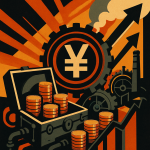Key Points
- Chinese baijiu stocks have faced significant headwinds, with the Baijiu Index down nearly 14% year-to-date in 2025 and nearly 50% since the start of 2023, driven by decelerating performance growth and declining wholesale prices.
- Despite the downturn, multiple funding sources, including margin traders, fund investors, and private equity firms, are increasing their positions in baijiu stocks and ETFs.
- Margin balance in the baijiu industry saw an increase of ¥20.17 billion RMB from its 2025 low point as of June 10.
- Fund investors are pouring into baijiu ETFs, notably the Penghua CSI Liquor ETF (鹏华中证酒ETF), which saw increases exceeding 300 million units on multiple recent days.
- Market analysts believe the baijiu industry is in a bottoming-out phase, citing low valuations, efforts to reduce inventory, and stable off-season prices for renowned brands, suggesting solid allocation value.

What’s the real deal with Chinese baijiu stocks right now?
It’s no secret they’ve been taking a beating, but dig a little deeper, and you’ll find a fascinating counter-trend: multiple funding sources are quietly increasing their positions.
Let’s break down what’s happening and what signals this might be sending to savvy investors.
The Sobering Reality: Baijiu Stocks Face Headwinds
The recent performance of baijiu stocks hasn’t been anything to toast to.
We’re seeing a backdrop of significantly decelerating performance growth and a continuous decline in baijiu wholesale prices.
Unsurprisingly, this has shaken the market.
The Baijiu Index itself has tumbled nearly 14% year-to-date in 2025.
That’s a pretty steep drop, folks.

Resume Captain
Your AI Career Toolkit:
- AI Resume Optimization
- Custom Cover Letters
- LinkedIn Profile Boost
- Interview Question Prep
- Salary Negotiation Agent

Several Big Names Take a Hit: Stocks Down Over 20%
The continuous slide in baijiu wholesale prices has definitely sparked concerns across the industry.
Industry data paints a clear picture: the Baijiu Index has been on a mostly downward trajectory since the year began.
Some specific baijiu stocks have felt this even more acutely:
- Yingjiagongjiu (迎驾贡酒)
- Jiuguijiu (酒鬼酒)
- Jinzhongzijiu (金种子酒)
- Shedejiuye (舍得酒业)
These names have all seen year-to-date declines exceeding 20%.
This isn’t a new story either.
Since the start of 2023, market confidence in baijiu has been relatively low.
Why? Key factors include:
- Decelerating industry growth
- High corporate inventories (translation: a lot of unsold booze)
- The widespread issue of product prices selling below their listed prices (倒挂) – a tough spot for any brand.
Market data is stark: the Baijiu Index has plummeted nearly 50% since the beginning of 2023.
Many individual stocks have experienced even more significant drops during this period.

Behind the Numbers: Performance Growth Slowdown
So, what’s fueling this continuous weakening?
It’s largely down to a significant slowdown in the industry’s performance growth in recent years.
Let’s look at the figures from Wind Data (Wind Shuju Wind数据), as compiled by journalists at Securities Times (Zhengjuan Shibao 证券时报):
- In 2024, A-share listed baijiu companies achieved total operating revenue of ¥4422.27 billion RMB ($614.20 billion USD).
- This represents a year-on-year increase of 2.28%.
- Net profit attributable to listed company shareholders was ¥1666.31 billion RMB ($231.43 billion USD).
- This was up 4.32% year-on-year.
While these are still growth figures, the pace has clearly slowed.
Overall, the baijiu industry is showing clear signs of differentiation.
Leading companies, the big dogs, are still managing to achieve growth, leveraging their strong brand recognition and channel advantages.
However, some regional distilleries are really feeling the squeeze, facing inventory backlogs and sales pressure, leading to more noticeable performance declines.
Many listed baijiu companies have openly stated that in 2024, the baijiu industry is generally still in a period of adjustment.
Industry competition is heating up, sales of baijiu products are under pressure, and customer confidence is still on the mend.
This is particularly true for mid-range and high-end products, where consumption demand still needs a significant rebound.

Find Top Talent on China's Leading Networks
- Post Across China's Job Sites from $299 / role, or
- Hire Our Recruiting Pros from $799 / role
- Qualified Candidate Bundles
- Lower Hiring Costs by 80%+
- Expert Team Since 2014
Your First Job Post

The Contrarian Move: Margin Traders and Funds Double Down
Now, here’s where it gets interesting.
Despite this gloomy picture, journalists at Securities Times (Zhengjuan Shibao 证券时报) have uncovered a fascinating trend: private equity firms, margin traders, and fund investors have recently started increasing their positions against the prevailing market sentiment.
This is a classic “be greedy when others are fearful” kind of move.

ExpatInvest China
Grow Your RMB in China:
- Invest Your RMB Locally
- Buy & Sell Online in CN¥
- No Lock-In Periods
- English Service & Data
- Start with Only ¥1,000

Margin Traders Sniffing Opportunity
A look at recent financing data for the baijiu industry shows that margin traders are continuously upping their stakes in baijiu stocks.
According to Wind Data (Wind Shuju Wind数据):
- The baijiu industry’s margin balance hit a low for the year at ¥315.03 billion RMB ($4.38 billion USD) on May 15.
- Since then, it’s been climbing steadily.
- As of June 10, the margin balance in the baijiu industry reached ¥335.20 billion RMB ($4.66 billion USD).
- That’s an increase of ¥20.17 billion RMB ($2.80 billion USD) from the year’s lowest point!
This suggests that traders using borrowed funds are seeing potential upside at current valuations.
- Lowest Point (May 15, 2025): ¥315.03 billion RMB ($4.38 billion USD)
- Margin Balance (June 10, 2025): ¥335.20 billion RMB ($4.66 billion USD)
- Increase since Low: ¥20.17 billion RMB ($2.80 billion USD)

Fund Investors Pour into Baijiu ETFs
It’s not just margin traders.
Fund investors are also showing renewed interest, specifically by increasing their holdings in baijiu ETFs.
Wind Data (Wind Shuju Wind数据) highlights a significant recent spike in the outstanding shares of the Penghua CSI Liquor ETF (Penghua Zhongzheng Jiu ETF 鹏华中证酒ETF).
- On June 5, June 6, and June 9, the increase in outstanding shares for this ETF exceeded 300 million units each day.
- On June 10, the outstanding shares of the Penghua CSI Liquor ETF (Penghua Zhongzheng Jiu ETF 鹏华中证酒ETF) increased by another 277 million units.
Thanks to this consistent inflow, the ETF’s scale has actually grown against the trend, even as the broader Baijiu Index continues to fall.
As of June 10, the latest scale of this ETF was a hefty ¥114.03 billion RMB ($1.58 billion USD).
- June 5: >300
- June 6: >300
- June 9: >300
- June 10: 277

Private Equity Joins the Fray: The Moutai Bet
And there’s more.
Some private equity firms have also indicated they’re increasing their baijiu stock positions.
A notable example comes from the shareholder meeting of the baijiu giant, Kweichow Moutai (Guizhou Maotai 贵州茅台), this year.
Well-known private equity veteran Linyuan (林园) made his stance clear: “Recently I am still buying Moutai stock; I will not reduce my holdings, only increase them.“
When a seasoned investor like Linyuan (林园) makes such a statement, it definitely turns heads.

Expert Takes: Is the Baijiu Sector Bottoming Out?
So, what do the analysts think about all this?
Huaxin Securities (Huaxin Zhengjuan 华鑫证券) offered their perspective on the current baijiu sector:
- From a fundamental perspective, they expect the demand for the baijiu industry to continue its bottoming trend.
- Overall business demand is under pressure, but banquet demand is showing differentiation (some segments doing better than others).
- Companies are actively working to reduce channel inventory, and overall inventory is being steadily digested. Good news.
- From a valuation perspective, the overall valuation of the sector is relatively low.
- They also note more stock buybacks and share increases by distilleries, plus a continuous increase in dividend payouts – all potentially attractive signs for investors.
- Key things to watch: the release of domestic demand policies and the potential for capital inflow into baijiu as an under-allocated sector.
Kaiyuan Securities (Kaiyuan Zhengjuan 开源证券) also weighed in, believing that the current baijiu industry is in a bottoming-out phase.
- Wholesale prices for renowned brands are holding stable during the off-season, and crucially, inventory isn’t accumulating further.
- Leading distilleries are getting creative, using model innovation to cope with cyclical pressure.
- They’re actively seeking new growth points and breaking through by:
- Transforming scenarios (how and where baijiu is consumed)
- Targeting new customer groups
- Expanding into baijiu cultural experiences
- While the baijiu industry is currently under short-term pressure from weak demand and sentiment disturbances, signs of a fundamental bottoming are gradually becoming evident.
- Combined with low valuations and increased dividends, the allocation value remains solid.
Kaiyuan Securities (Kaiyuan Zhengjuan 开源证券) specifically recommends focusing on high-end baijiu regional leaders.
Their advice? Wait for the demand recovery anticipated in the second half of the year and the potential for a resonance of valuation repair.
In essence, while the baijiu market has faced undeniable turbulence, the actions of these varied funding channels suggest a belief that the sector’s investment value is re-emerging, potentially signaling a prime opportunity for those looking at Chinese baijiu stocks.

![Magnetic Levitation Compressors: Skyrocketing Demand & Hot Stocks in the AI Era [FreshFromChina]](https://freshfromchina.com/wp-content/uploads/2025/05/magnetic_levitation_compressors_skyrocketing_demand_hot_stocks_ai_era.png____FreshFromChina-150x150.png)



